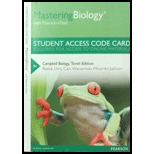
Mastering Biology with Pearson eText -- Standalone Access Card -- for Campbell Biology (10th Edition)
10th Edition
ISBN: 9780321833143
Author: Jane B. Reece, Lisa A. Urry, Michael L. Cain, Steven A. Wasserman, Peter V. Minorsky, Robert B. Jackson
Publisher: PEARSON
expand_more
expand_more
format_list_bulleted
Concept explainers
Textbook Question
Chapter 36, Problem 6TYU
A plant cell with a of -0.65 MPa maintains a constant volume when bathed in a solution that has a Ψs of-0.30 MPa and is in an open container. The cell has a
- (A) Ψp of +0.65 MPa.
- (B) Ψ of -0.65 MPa.
- (C) Ψp of+0.35 MPa.
- (D) Ψp of 0 MPa.
Expert Solution & Answer
Want to see the full answer?
Check out a sample textbook solution
Students have asked these similar questions
Plating 50 microliters of a sample diluted by a factor of 10-6 produced 91 colonies. What was the originalcell density (CFU/ml) in the sample?
Every tutor here has got this wrong, don't copy off them.
Suppose that the population from question #1 (data is in table below) is experiencing inbreeding depression (F=.25) (and no longer experiencing natural selection). Calculate the new expected genotype frequencies (f) in this population
after one round of inbreeding. Please round to 3 decimal places.
Genotype
Adh Adh
Number of Flies
595
Adh Adh
310
Adhs Adhs
95
Total
1000
fladh Adh-
flAdn Adh
fAdhs Adh
Chapter 36 Solutions
Mastering Biology with Pearson eText -- Standalone Access Card -- for Campbell Biology (10th Edition)
Ch. 36.1 - Why is long-distance transport important for...Ch. 36.1 - Prob. 2CCCh. 36.1 - Some plants can detect increased levels of light...Ch. 36.1 - WHAT IF? If you prune a plant's shoot tips, what...Ch. 36.1 - Prob. 5CCCh. 36.2 - If a plant cell immersed in distilled water has a...Ch. 36.2 - Prob. 2CCCh. 36.2 - How would the long-distance transport of water be...Ch. 36.2 - Prob. 4CCCh. 36.3 - Prob. 1CC
Ch. 36.3 - Prob. 2CCCh. 36.3 - Prob. 3CCCh. 36.3 - WHAT IF? Suppose an Arabidopsis mutant lacking...Ch. 36.3 - MAKE CONNECTIONS How are the Casparian strip and...Ch. 36.4 - Prob. 1CCCh. 36.4 - Prob. 2CCCh. 36.4 - WHAT IF? If you buy cut flowers, why might the...Ch. 36.4 - Prob. 4CCCh. 36.5 - Prob. 1CCCh. 36.5 - Prob. 2CCCh. 36.5 - Prob. 3CCCh. 36.5 - WHAT IF? Apple growers in Japan sometimes make a...Ch. 36.6 - How do plasmodesmata differ from gap junctions?Ch. 36.6 - Prob. 2CCCh. 36.6 - WHAT IF? Suppose plants were genetically modified...Ch. 36 - How did the evolution of xylem and phloem...Ch. 36 - Is xylem sap usually pulled or pushed up the...Ch. 36 - Prob. 36.3CRCh. 36 - Prob. 36.4CRCh. 36 - Prob. 36.5CRCh. 36 - By what mechanisms is symplastic communication...Ch. 36 - Prob. 1TYUCh. 36 - Prob. 2TYUCh. 36 - Prob. 3TYUCh. 36 - Photosynthesis ceases when leaves wilt, mainly...Ch. 36 - Prob. 5TYUCh. 36 - A plant cell with a of -0.65 MPa maintains a...Ch. 36 - Compared with a cell with few aquaporin proteins...Ch. 36 - Prob. 8TYUCh. 36 - EVOLUTION CONNECTION Large brown algae called...Ch. 36 - SCIENTIFIC INQUIRY INTERPRET THE DATA A Minnesota...Ch. 36 - SCIENTIFIC INQUIRY Cotton plants wilt within a few...Ch. 36 - WRITE ABOUT A THEME: ORGANIZATION Natural...Ch. 36 - Prob. 13TYU
Knowledge Booster
Learn more about
Need a deep-dive on the concept behind this application? Look no further. Learn more about this topic, biology and related others by exploring similar questions and additional content below.Similar questions
- Which of the following best describes why it is difficult to develop antiviral drugs? Explain why. A. antiviral drugs are very difficult to develop andhave no side effects B. viruses are difficult to target because they usethe host cell’s enzymes and ribosomes tometabolize and replicate C. viruses are too small to be targeted by drugs D. viral infections usually clear up on their ownwith no problemsarrow_forwardThis question has 3 parts (A, B, & C), and is under the subject of Nutrition. Thank you!arrow_forwardThey got this question wrong the 2 previous times I uploaded it here, please make sure it's correvct this time.arrow_forward
- This question has multiple parts (A, B & C), and under the subject of Nutrition. Thank you!arrow_forwardCalculate the CFU/ml of a urine sample if 138 E. coli colonies were counted on a Nutrient Agar Plate when0.5 mls were plated on the NA plate from a 10-9 dilution tube. You must highlight and express your answerin scientific notatioarrow_forwardDon't copy off the other answer if there is anyarrow_forward
arrow_back_ios
SEE MORE QUESTIONS
arrow_forward_ios
Recommended textbooks for you
 Human Physiology: From Cells to Systems (MindTap ...BiologyISBN:9781285866932Author:Lauralee SherwoodPublisher:Cengage Learning
Human Physiology: From Cells to Systems (MindTap ...BiologyISBN:9781285866932Author:Lauralee SherwoodPublisher:Cengage Learning Principles Of Radiographic Imaging: An Art And A ...Health & NutritionISBN:9781337711067Author:Richard R. Carlton, Arlene M. Adler, Vesna BalacPublisher:Cengage Learning
Principles Of Radiographic Imaging: An Art And A ...Health & NutritionISBN:9781337711067Author:Richard R. Carlton, Arlene M. Adler, Vesna BalacPublisher:Cengage Learning Biology: The Dynamic Science (MindTap Course List)BiologyISBN:9781305389892Author:Peter J. Russell, Paul E. Hertz, Beverly McMillanPublisher:Cengage Learning
Biology: The Dynamic Science (MindTap Course List)BiologyISBN:9781305389892Author:Peter J. Russell, Paul E. Hertz, Beverly McMillanPublisher:Cengage Learning

Human Physiology: From Cells to Systems (MindTap ...
Biology
ISBN:9781285866932
Author:Lauralee Sherwood
Publisher:Cengage Learning




Principles Of Radiographic Imaging: An Art And A ...
Health & Nutrition
ISBN:9781337711067
Author:Richard R. Carlton, Arlene M. Adler, Vesna Balac
Publisher:Cengage Learning

Biology: The Dynamic Science (MindTap Course List)
Biology
ISBN:9781305389892
Author:Peter J. Russell, Paul E. Hertz, Beverly McMillan
Publisher:Cengage Learning
The Cell Membrane; Author: The Organic Chemistry Tutor;https://www.youtube.com/watch?v=AsffT7XIXbA;License: Standard youtube license